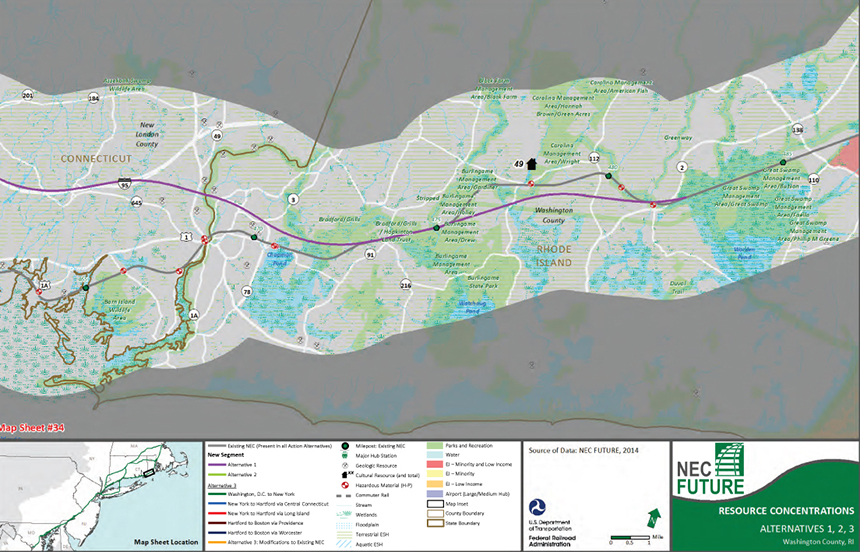By FRANK CARINI/ecoRI News staff

The proposed path of the new Northeast Corridor railroad through
the Rhode Island towns of Westerly and Charlestown has some officials and
residents worried. (NEC Future environmental impact statement)
The Federal Railroad Administration, about a week before
Christmas, released its final environmental impact statement regarding the
straightening of Northeast Corridor tracks, from Washington, D.C., to Boston,
during the next few decades.
Impacted communities, including Charlestown, South Kingstown and Westerly, R.I.,
and Old Lyme, Conn., have 30 days to respond. The comment period is open until Jan. 31.
The Federal Railroad Administration (FRA)
has estimated the cost of its proposal at nearly $130 billion, plus an
additional $2 billion annually to operate. Northeast Corridor (NEC) states will be
expected to pay part of the cost, and the project can’t happen without approval
from the corridor’s eight states.
The proposed new railroad path would cut off an estimated 45
minutes of travel time between New York City and Boston, according to the FRA’s NEC
Future initiative, by straightening out curves that currently
exist in the tracks.
Both public and private property could be impacted, including some
sensitive areas.
The proposal calls for rerouting the tracks through Grills Preserve in
Westerly, and through Charlestown's Frances C. Carter Memorial Preserve and Amos Green Farm.
The new tracks would rejoin the old rail bed in the Great Swamp
Management Area in South Kingstown, where a third rail would be added to
increase railroad width by 50 percent, according to NEC Future.
Some wetlands would reportedly be filled in Burlingame and the
Great Swamp Management areas, and in Indian Cedar Swamp. The project also calls
for the possibility of blasting and trenching.
Gregory Stroud, executive director of SECoast,
recently told The Connecticut Mirror he’s
no fan of the plan.
“A $100 billion dollar infrastructure project shouldn’t be
planned in secret and announced by surprise, on a Friday (Dec. 16), just nine
days before the Christmas holiday,” he told the newspaper.
“This sets a terrible precedent, not just for NEC Future, but for
all of the infrastructure projects planned for towns across Connecticut over
the next two decades. This isn’t how you announce a good plan, or a plan with
real public support.”
At a Dec. 16 press conference in Hartford, Sen. Richard
Blumenthal, D-Conn., said “this concept and plan, just to reassure people in
Connecticut, is simply not happening,” according to the same Mirror story.
Other environmentalists and officials in both Connecticut and
Rhode Island have noted their concerns. In a Dec. 19 e-mail to ecoRI News, a
Rhode Island planning board official, who wished not be identified, wrote, “The
proposed rail line appears to cut through state and private properties
including the middle the Francis Carter Preserve ... this would make it
dangerous for wildlife and people to use and negate its value. Wildlife and
important flora will be affected.”
In a Dec. 21 e-mail to ecoRI News, Kristen Castrataro wrote that
the proposed track changes would impact the entire state. The Richmond resident
noted that FRA's environmental impact statement indicated that 11 Rhode Island cultural resources and historic
properties would be impacted.
Castrataroalso noted two other concerns: the proposal would impact
an additional 200 acres of prime Ocean State
farmland; and, of the eight states and the District of Columbia
named in the plan, Rhode Island would have the highest acreage of parkland — more than
50 acres — "converted to a transportation use."
NEC Future is a comprehensive planning effort to define, evaluate
and prioritize future investments in the Northeast Corridor. The FRA launched
the initiative in February 2012, to consider the role of rail passenger service
in the context of current and future transportation demands.
Amtrak’s Stephen Gardner, who is in charge of business operations
on the corridor, told The Associated Press that
the plan affirms the railroad’s “long-held view that rebuilding and expanding
the Northeast Corridor is essential for the growth and prosperity of the entire
region.”
The 457-mile NEC — anchored by D.C.’s Union Station in the south,
New York’s Pennsylvania Station in the center and Boston's South Station in the
north — is one of the most heavily traveled rail corridors in the world,
according to the FRA.
The NEC is shared by intercity, commuter and freight
operations, and moves more than 365 million passengers and 14 million car-miles
of freight annually.
While improvements continue to be made, the FRA says NEC faces
serious challenges, with century-old infrastructure, outdated technology and
inadequate capacity to meet current or projected travel demand.
Sen. Jack Reed, D-R.I., is a proponent of the plan and was
against Providence not being included in the project.
“One of the key points we’ve made emphatically is that Providence
station has to be a key part of the Northeast Corridor and that’s been accepted
by the secretary of transportation and everyone else,” Reed told WPRI Eyewitness News earlier
this month. “It has to be an integral part because it’s important not only to
Rhode Island but to the whole region.”
Reed is the top Democrat on the appropriations subcommittee that
allocates Amtrak funding.